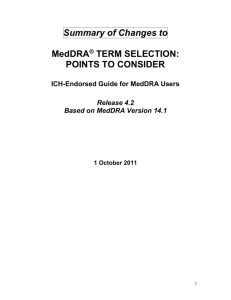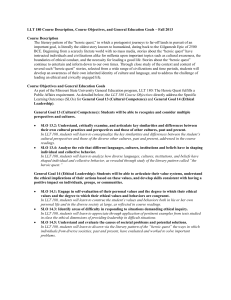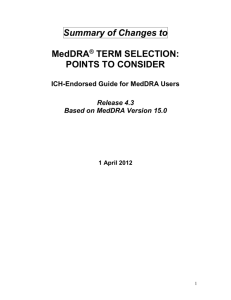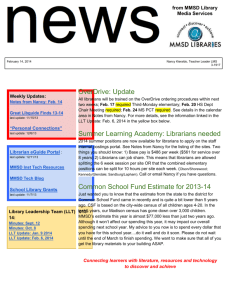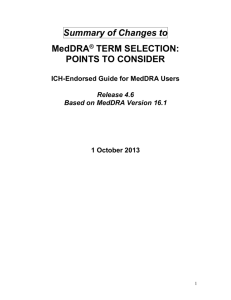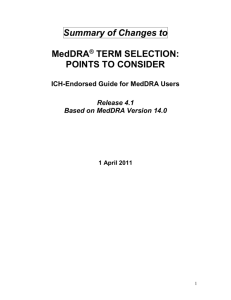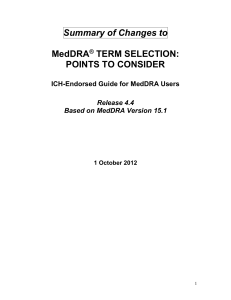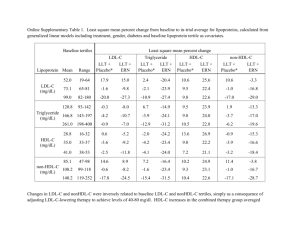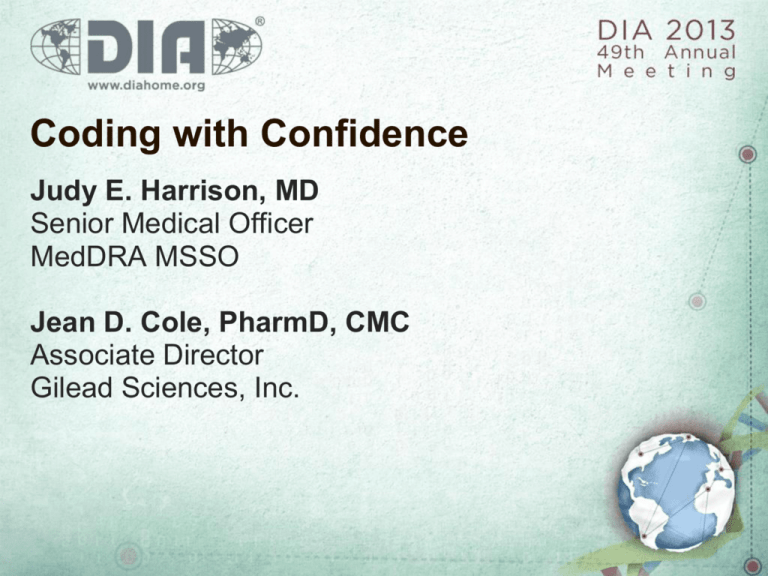
Coding with Confidence
Judy E. Harrison, MD
Senior Medical Officer
MedDRA MSSO
Jean D. Cole, PharmD, CMC
Associate Director
Gilead Sciences, Inc.
Disclaimer
• The views and opinions expressed in the following PowerPoint
slides are those of the individual presenter and should not be
attributed to Drug Information Association, Inc. (“DIA”), its
directors, officers, employees, volunteers, members, chapters,
councils, Communities (formerly known as SIACs) or affiliates, or
any organization with which the presenter is employed or
affiliated.
• These PowerPoint slides are the intellectual property of the
individual presenter and are protected under the copyright laws
of the United States of America and other countries. Used by
permission. All rights reserved. Drug Information Association,
Drug Information Association Inc., DIA and DIA logo are
registered trademarks. All other trademarks are the property of
their respective owners.
2
Disclosure
• Judy Harrison, M.D. is a consultant to Northrop
Grumman Information Systems/MedDRA
MSSO
• MedDRA MSSO provides MedDRA via
subscription to its users and provides training
and other MedDRA-related services
3
Learning Objectives
• Describe how to code clinical safety
data accurately and consistently with
MedDRA
• Apply the principles described in the
ICH-endorsed “MedDRA Term
Selection: Points to Consider” document
4
Workshop Overview
• MedDRA refresher
• “MedDRA Term Selection: Points to
Consider” document
• Browsing and coding tips and tricks
• Practical exercises
• Best practices
5
MedDRA Refresher
6
MedDRA Definition
MedDRA is a clinically-validated international
medical terminology used by regulatory
authorities and the regulated
biopharmaceutical industry. The terminology
is used through the entire regulatory
process, from pre-marketing to postmarketing, and for data entry, retrieval,
evaluation, and presentation.
7
Scope of MedDRA
Not a drug
dictionary
Patient demographic
terms
Clinical trial study
design terms
OUT
IN
Frequency
qualifiers
Medical conditions
Indications
Numerical values for
Investigations (tests, results)
results
Medical and surgical procedures
Medical, social, family history
Medication errors
Product quality issues
Severity descriptors
Device-related issues
Pharmacogenetic terms
Toxicologic issues
Not an equipment, device,
Standardized queries
diagnostic product
dictionary
8
MedDRA Structure
System Organ Class (SOC) (26)
High Level Group Term (HLGT) (334)
High Level Term (HLT) (1,717)
Preferred Term (PT) (20,057)
Lowest Level Term (LLT) (71,326)
MedDRA Version 16.0
9
9
9
System Organ Classes
•
•
•
•
•
•
•
•
•
•
•
•
•
•
Blood and lymphatic system disorders
Cardiac disorders
Congenital, familial and genetic disorders
Ear and labyrinth disorders
Endocrine disorders
Eye disorders
Gastrointestinal disorders
General disorders and administration site
conditions
Hepatobiliary disorders
Immune system disorders
Infections and infestations
Injury, poisoning and procedural
complications
Investigations
Metabolism and nutrition disorders
•
•
•
•
•
•
•
•
•
•
•
•
Musculoskeletal and connective tissue
disorders
Neoplasms benign, malignant and unspecified
(incl cysts and polyps)
Nervous system disorders
Pregnancy, puerperium and perinatal
conditions
Psychiatric disorders
Renal and urinary disorders
Reproductive system and breast disorders
Respiratory, thoracic and mediastinal disorders
Skin and subcutaneous tissue disorders
Social circumstances
Surgical and medical procedures
Vascular disorders
10
Examples of LLTs
SOC = Cardiac disorders
HLGT = Cardiac arrhythmias
HLT = Rate and rhythm disorders NEC
PT = Arrhythmia
LLT
Arrhythmia
NOS
LLT
Dysrhythmias
LLT (Non-current)
Other specified cardiac
dysrhythmias
LLT
Arrhythmia
11
Non-Current Terms
• Non-current terms are flagged at the
LLT level within MedDRA
• Not recommended for continued use
• Retained within the terminology to
preserve historical data for retrieval and
analysis
• Terms that are vague, ambiguous, outdated, truncated, or misspelled
• Terms derived from other terminologies
that do not fit MedDRA rules
12
MedDRA Codes
• Each MedDRA term has an 8-digit code
• Codes used for electronic submissions
13
13
13
Language Translations
•Chinese
•Czech
•Dutch
•English
•French
•German
•Hungarian
•Italian
•Japanese
•Portuguese
•Spanish
14
14
A Multi-Axial Terminology
• Multi-axial = the representation of a
medical concept in multiple SOCs
– Allows grouping by different classifications
– Allows retrieval and presentation via different
data sets
• Purpose of Primary SOC
– Determines which SOC will represent a PT
during cumulative data outputs
– Is used to support consistent data
presentation for reporting to regulators
15
A Multi-Axial Terminology (cont)
SOC = Respiratory, thoracic and
mediastinal disorders
HLGT = Respiratory tract
infections
SOC = Infections and
infestations
HLGT = Viral infectious
disorders
HLT = Viral upper respiratory
tract infections
HLT = Influenza viral
infections
PT = Influenza
16
A Multi-Axial Terminology (cont)
• PTs in the following SOCs only appear
in that particular SOC and not in others;
i.e., they are not multi-axial:
– Investigations
– Surgical and medical procedures
– Social circumstances
17
Rules for Primary SOC Allocation
• PTs for diseases, signs and symptoms are assigned to
prime manifestation site SOC
• Congenital and hereditary anomalies terms have SOC
Congenital, familial and genetic disorders as Primary
SOC
• Neoplasms terms have SOC Neoplasms benign,
malignant and unspecified (incl cysts and polyps) as
Primary SOC
– Exception: Cysts and polyps have prime manifestation site SOC
as Primary SOC
• Infections and infestations terms have SOC Infections
and infestations as Primary SOC
18
Primary SOC Priority
• If a PT links to more than one of the
exceptions, the following priority will be
used to determine primary SOC:
1st: Congenital, familial and genetic
disorders
2nd: Neoplasms benign, malignant and
unspecified (incl cysts and polyps)
3rd: Infections and infestations
19
EU Pharmacovigilance Directive
20
EU Pharmacovigilance Directive (cont)
Chapter 17
Member States should operate a pharmacovigilance
system to collect information that is useful for the
monitoring of medicinal products, including information
on suspected adverse reactions arising from use of a
medicinal product within the terms of the marketing
authorisation as well as from use outside the terms of
the marketing authorisation, including overdose,
misuse, abuse and medication errors, and suspected
adverse reactions associated with occupational
exposure.
21
Revisions Related to
New EU PV Legislation
• Significant revisions to MedDRA Term Selection:
Points to Consider for Release 4.5, based on
MedDRA v16.0 (1 April 2013)
– Definitions added (consistent with international
regulatory authorities’ definitions)
– Examples added
– New section on Misuse, Abuse and Addiction
• MedDRA Introductory Guide v16.0 (1 March 2013)
– Definitions added (consistent with MTS:PTC definitions)
• MedDRA v16.0 (1 March 2013)
– Added new HLT Occupational exposures
22
22
“MedDRA Term Selection:
Points to Consider” Document
23
MedDRA Term Selection:
Points to Consider (MTS:PTC)
• An ICH-endorsed guide for MedDRA users
• Provides term selection advice for industry
and regulatory purposes
• Objective is to promote accurate and
consistent term selection to facilitate a
common understanding of shared data
• Recommended to be used as the basis for
individual organizations’ coding
conventions
24
MedDRA Term Selection: PTC (cont)
• Developed by a working group of the ICH Steering
Committee
– Regulators and industry representatives
– EU, Japan, USA
– Canadian observer, MSSO, JMO
• Updated twice yearly with each MedDRA release
• Available on MSSO, JMO, and ICH Web sites
– English and Japanese
– Variety of file formats for ease of viewing and editing
– Summary of Changes document
25
MTS:PTC Points of Note
• In some cases with more than one option
for selecting terms, a “preferred option” is
identified but this does not limit MedDRA
users to applying that option.
Organizations should be consistent in their
choice of option.
• Section 4.1 – Versioning (Appendix)
– 4.1.1 Versioning methodologies
– 4.1.2 Timing of version implementation
26
General Term Selection Principles
•
•
•
•
•
•
•
•
•
•
Quality of Source Data
Quality Assurance
Do Not Alter MedDRA
Always Select a Lowest Level Term
Select Only Current Lowest Level Terms
When to Request a Term
Use of Medical Judgment in Term Selection
Selecting More than One Term
Check the Hierarchy
Select Terms for All Reported Information, Do Not
Add Information
27
Do Not Alter MedDRA
• MedDRA is a standardized terminology
with a pre-defined term hierarchy
• Users must not make ad hoc structural
alterations, including changing the primary
SOC allocation
• If terms are incorrectly placed, submit a
change request to the MSSO
28
28
Always Select a Lowest Level Term
• Lowest Level Term that most accurately
reflects the reported verbatim
information should be selected
• Degree of specificity may be
challenging
– Example: “Abscess on face” select
“Facial abscess,” not simply “Abscess”
29
Term Selection Points
• Diagnoses and Provisional Diagnoses with or without Signs
and Symptoms
• Death and Other Patient Outcomes
• Suicide and Self-Harm
• Conflicting/Ambiguous/Vague Information
• Combination Terms
• Age vs. Event Specificity
• Body Site vs. Event Specificity
• Location Specific vs. Microorganism Specific Information
• Modification of Pre-existing Conditions
• Exposures During Pregnancy and Breast Feeding
• Congenital Terms
• Neoplasms
• Medical and Surgical Procedures
• Investigations
30
Term Selection Points (cont)
• Medication/Administration Errors, Accidental Exposures and
Occupational Exposures
• Misuse, Abuse and Addiction
• Transmission of Infectious Agent via Product
• Overdose, Toxicity and Poisoning
• Device-related Terms
• Drug Interactions
• No Adverse Effect and “Normal” Terms
• Unexpected Therapeutic Effect
• Modification of Effect
• Social Circumstances
• Medical and Social History
• Indication for Product Use
• Off Label Use
• Product Quality Issues
31
Diagnoses and Provisional Diagnoses
SINGLE DIAGNOSIS
DEFINITIVE DIAGNOSIS
PROVISIONAL DIAGNOSIS
Single diagnosis without signs
and symptoms
Single provisional diagnosis
without signs and symptoms
•Diagnosis (only possible option) •Provisional diagnosis (only
possible option)
Example: “Myocardial
infarction” select
Example: “Possible myocardial
infarction” select
“Myocardial infarction” (select
term as if definitive diagnosis)
“Myocardial infarction”
Similar principles apply for multiple diagnoses
32
Diagnoses and Provisional Diagnoses (cont)
SINGLE DIAGNOSIS
DEFINITIVE DIAGNOSIS
PROVISIONAL DIAGNOSIS
Single diagnosis with signs/
symptoms
Single provisional diagnosis with
signs/symptoms
•Preferred: Diagnosis only
•Preferred: Provisional
diagnosis and signs/symptoms
Example: “Anaphylactic
Example: “Possible myocardial
reaction with rash, dyspnea,
hypotension, and laryngospasm”
select “Anaphylactic
reaction”
33
infarction with chest pain,
dyspnea, diaphoresis” select
“Myocardial infarction” “Chest
pain”, “Dyspnea”, and
“Diaphoresis”
Diagnoses and Provisional Diagnoses (cont)
SINGLE DIAGNOSIS
DEFINITIVE DIAGNOSIS
PROVISIONAL DIAGNOSIS
Single diagnosis with signs/
symptoms
Single provisional diagnosis with
signs/symptoms
•Alternate: Diagnosis and
signs/symptoms
•Alternate: Signs/symptoms
only (as provisional diagnosis
may change
Example: “Anaphylactic reaction Example: “Possible myocardial
with rash, dyspnea, hypotension, infarction with chest pain,
and laryngospasm” select
dyspnea, diaphoresis” select
“Anaphylactic reaction”, “Rash”, “Chest pain”, “Dyspnea”, and
“Dyspnea”, Hypotension”, and
“Diaphoresis”
“Laryngospasm”
34
Diagnoses and Provisional Diagnoses (cont)
• Always include signs/symptoms not associated
with diagnosis
Reported
LLT Selected
Myocardial infarction
Myocardial infarction, chest
Jaundice (note that jaundice is
pain, dyspnea, diaphoresis,
not typically associated with
ECG changes and jaundice
myocardial infarction)
35
Conflicting/Ambiguous Information
• First, try to obtain more specific information
Reported
Hyperkalemia with a
serum potassium of 1.6
mEq/L
GU pain
LLT Selected
Comment
Serum potassium
abnormal
LLT Serum potassium
abnormal covers both of
the reported concepts
(note: serum potassium of
1.6 mEq/L is a low result,
not high)
Pain
“GU” could be either
“genito-urinary” or “gastric
ulcer”. If additional
information is not available,
then select a term to
reflect the information
that is known, i.e., LLT Pain
36
Vague Information
• First, try to obtain more specific information
Reported
Turned green
Patient had a medical
problem of unclear type
LLT Selected
Comment
Unevaluable event
“Turned green” reported
alone is vague; this could
refer to a patient condition
or even to a product (e.g.,
pills)
Ill-defined disorder
37
Since it is known that there
is some form of a medical
disorder, LLT Ill-defined
disorder can be selected
37
Combination Terms
• One condition is more specific than the other
Reported
LLT Selected
Arrhythmia due to atrial
fibrillation
Atrial fibrillation
• A MedDRA combination term is available
Reported
LLT Selected
Retinopathy due to diabetes
Diabetic retinopathy
38
Combination Terms (cont)
• If splitting provides more clinical information,
select more than one term
• In all cases of combination terms, apply medical
judgment
Reported
LLT Selected
Diarrhea and vomiting
Diarrhea
Vomiting
Wrist fracture due to fall
Wrist fracture
Fall
39
Medication Errors
See Appendix B of MedDRA Introductory Guide for
Concept Descriptions
“Top-down” navigation in HLGT Medication errors
is best approach for term selection
• Medication error with clinical consequences
Reported
LLT Selected
Patient was administered wrong
drug and experienced hypotension
Wrong drug administered
Hypotension
Because of similar sounding drug
names, the patient took the wrong
drug and experienced a rash
Drug name confusion
Wrong drug administered
Rash
40
Medication Errors (cont)
Important to record occurrence or potential
occurrence of medication error
• Medication error without clinical consequences
Reported
LLT Selected
Comment
Medication was given
intravenously instead of
intramuscularly without
sequelae
Intramuscular
formulation
administered by other
route
No adverse effect
If specifically reported
that there is no adverse
effect, acceptable to
select LLT No adverse
Pharmacist notices that
the names of two drugs
are similar and is
concerned that this may
result in a medication
error
Circumstance or
information capable of
leading to medication
error
41
effect
LLT Drug name
confusion could be an
optional additional term
to select. Note: this
example is a potential
medication error.
Misuse, Abuse and Addiction
New MTS:PTC Section
42
FDA-Defined Coding Errors
• Missed Concepts
– All medical concepts described after the product is
taken should be coded
– Example: “The patient took drug X and developed
alopecia, increased LFTs and pancreatitis”.
Manufacturer only codes alopecia and increased
LFTs (missed concept of pancreatitis)
– Example: “The patient took drug X and developed
interstitial nephritis which later deteriorated into
renal failure”. Manufacturer only codes interstitial
nephritis (missed renal failure concept)
Acknowledgement: Dr. Toni Piazza-Hepp, Office of Surveillance
and Epidemiology, CDER
43
FDA-Defined Coding Errors (cont)
• “Soft Coding”
– Selecting a term which is both less specific and less
severe than another MedDRA term is “soft coding”
– Example: “Liver failure” coded as hepatotoxicity or
increased LFTs
– Example: “Aplastic anemia” coded as unspecified
anemia
– Example: “Rash subsequently diagnosed as
Stevens Johnson syndrome” coded as rash
Acknowledgement: Dr. Toni Piazza-Hepp, Office of Surveillance
and Epidemiology, CDER
44
Practical Experience Applying
Coding Principles and
Conventions
Jean D. Cole, PharmD, CMC
Assoc. Dir., Drug Safety & Public Health
Gilead Sciences, Inc.
Speaker Disclosure
• I have no real or apparent relationships to
disclose, financial or other, that would
affect my ability to make an unbiased
presentation on this topic.
• I do not intend to reference unlabeled or
unapproved uses of any particular drug or
to promote any product in any way.
46
Overview
• Examples: assessing verbatims and
selecting MedDRA terms
• Interactive exercises
• Pitfalls and solutions
• Tips for coding medication errors and
product quality issues and for handling
abbreviations
• Sharing best practices
47
Assessing the Reported Information
• Consider what is being reported. Is it a:
–
–
–
–
–
–
–
–
–
–
Clinical condition - Diagnosis, sign or symptom?
Indication?
Test result?
Injury?
Procedure?
Medication error?
The type of report will
influence the way you
Product quality issue?
search for a suitable LLT.
Social circumstance?
It may indicate in which
Device issue?
SOC you expect to find
the closest match.
Procedural complication?
– Is it a combination of these?
48
MedDRA Browsing Tips
•
•
•
•
•
•
•
•
First, try using actual words from reporter
Use “top-down” and “bottom-up” approaches
Look at the “neighbors”
Check the hierarchy
Consider synonyms, e.g., “Liver” and “Hepatic”
Use word stems, e.g., “Pancrea”
Search different word orders, “and”, “or”, etc.
Use available resources for difficult verbatim
terms (web search, medical dictionaries,
colleagues)
49
Example 1:
Diagnoses, Signs, and Symptoms
• “Altered mental status and arm weakness
– cerebrovascular accident versus
postictal state”
50
50
Example 1: Assessing the Verbatim
• “Altered mental status and arm weakness
– cerebrovascular accident versus
postictal state”
– Altered mental status = sign/symptom
– Arm weakness = sign/symptom
– Cerebrovascular accident = one provisional
diagnosis
– Postictal state = another provisional diagnosis
51
51
Example 1: Term Selection
• “Altered mental status and arm weakness
– cerebrovascular accident versus
postictal state”
– Consult PTC 3.1
– Preferred option is to code signs, symptoms,
and all provisional diagnoses
– S/Sx: LLT Mental status changes, LLT
Weakness of arms
– Provisional Dx: LLT Cerebrovascular
accident, LLT Postictal state
52
52
Example 2: Combination Concepts
and Complications
• “Hypersensitivity reaction manifesting as
interstitial nephritis, complicated by
hyperkalemia”
53
53
Example 2: Assessing the Verbatim
• “Hypersensitivity reaction manifesting as
interstitial nephritis, complicated by
hyperkalemia”
54
54
Example 2: Term Selection
• “Hypersensitivity reaction manifesting as
interstitial nephritis, complicated by
hyperkalemia”
• Check for applicable combination terms:
– LLT Nephritis allergic found
– Better than coding to both LLT Nephritis
interstitial and LLT Hypersensitivity reaction
(preserves relationship between mechanism
and manifestation; loss of “interstitial” is
acceptable based on medical judgment)
• Code the complication:
– LLT Hyperkalemia (not adequately expressed
in LLT Nephritis allergic)
55
55
Exercise 1: Complications
Which term(s) would you choose?
• “Hypertensive crisis resulting in organ
failure (multiple): encephalopathy, acute
renal failure and oliguria”
a) LLT Hypertensive crisis
b) LLT Organ failure
c) LLT Multiple organ failure
d) LLT Encephalopathy
e) LLT Hypertensive encephalopathy
f) LLT Hypertensive nephropathy
g) LLT Acute oliguric renal failure
56
56
Exercise 1: Suggested Terms
• “Hypertensive crisis resulting in organ failure
(multiple): encephalopathy, acute renal failure
and oliguria”
a) LLT Hypertensive crisis (exact match)
b) LLT Organ failure
c) LLT Multiple organ failure (more specific)
d) LLT Encephalopathy
e) LLT Hypertensive encephalopathy (good combination
term; captures causal relationship)
f) LLT Hypertensive nephropathy
g) LLT Acute oliguric renal failure (good combination
term; captures reporter’s words and severity of event)
57
57
Exercise 2: Investigation Terms
- PTC 3.14
• “Routine labs showed marked elevations
in ALT, alkaline phosphatase, and
bilirubin.”
a) LLT Hepatobiliary disease
b) LLT ALT increased, LLT Alkaline
phosphatase increased, LLT Bilirubin
elevated
c) LLT Raised liver function tests
d) LLT Elevated liver enzymes, LLT Bilirubin
elevated
58
58
Exercise 2: Investigation Terms
• “Routine labs showed marked elevations
in ALT, alkaline phosphatase, and
bilirubin.”
a) LLT Hepatobiliary disease (disorder term)
b) LLT ALT increased, LLT Alkaline
phosphatase increased, LLT Bilirubin
elevated (specificity preserved)
c) LLT Raised liver function tests (specificity
lost)
d) LLT Elevated liver enzymes, LLT Bilirubin
elevated (specificity lost)
59
59
Pitfalls and Solutions, 1
• Do not subtract information (code all
relevant information)
• Do not add information by coding to a
diagnosis that is not explicitly stated in the
verbatim Reread verbatim carefully,
resist any internal or external pressure to
code to unstated diagnoses
– If the physician who actually saw the patient
was not comfortable committing to a
diagnosis, why should you be?
60
60
Pitfalls and Solutions, 2
• In selecting an LLT for a result of an investigation,
parent PT of the selected LLT should contain a
qualifier/adjective
– E.g., “present/absent”, “increased/decreased”, etc.
• If parent PT of selected LLT does not contain a
qualifier/adjective, you may have inadvertently
selected an LLT for the test name, not a result
– E.g., “Blood found in urine”, select LLT Blood in
urine (PT Blood urine present). Do not select LLT
Blood urine (PT Blood urine has no qualifier/
adjective and thus represents the test name only)
61
61
Pitfalls and Solutions, 3
• Not finding the most specific term Combine
bottom-up and top-down searches
– For “rheumatoid arthritis in a 6-year old”,
select LLT Juvenile rheumatoid arthritis,
not LLT Rheumatoid arthritis
• Inadvertently sacrificing detail at the PT level to
capture detail in an LLT Check hierarchy
– For “intermittent migraine headaches”,
use LLT Migraine headache PT Migraine,
not LLT Intermittent headache PT Headache
62
62
Pitfalls and Solutions, 4
• Inappropriate terms selected by autocoder
Review all weight-based autocoding
carefully, apply medical judgment
– “Allergic to CAT scan” autocoded as
LLT Allergic to cats
– “Myocardial infarction in the fall of 2000”
autocoded as LLT Myocardial infarction and
LLT Fall
63
63
Tips for Coding Medication Errors
and Product Quality Issues
• See Appendix B of MedDRA Introductory Guide
for Concept Descriptions
• “Top-down” navigation in HLGT Medication
errors and HLGT Product quality issues is best
approach for term selection
• Read the LLTs to better understand the meaning
of the PTs:
– For example, PT Wrong technique in drug usage
process includes LLTs like Wrong injection technique
and Tablet crushed incorrectly
– Code all elements, including associated AEs
64
64
Exercise 3: Product Quality Issue
• “A patient who had been receiving epidural
injections of a compounded, preservativefree corticosteroid for severe back pain
presented to the ER with chest pain,
headache, and a fever. He was diagnosed
with fungal meningitis due to Exserohilum
rostratum, which was attributed to the use
of a contaminated lot of the corticosteroid.
Unfortunately, the event was fatal.”
65
65
Exercise 3: Assessing the Verbatim
• “A patient who had been receiving epidural
injections of a compounded, preservativefree corticosteroid for severe back pain
presented to the ER with chest pain,
headache, and a fever. He was diagnosed
with fungal meningitis due to Exserohilum
rostratum, which was attributed to the use
of a contaminated lot of the corticosteroid.
Unfortunately, the event was fatal.”
66
66
Exercise 3: Signs, Symptoms &
Diagnosis – PTC 3.1
• “…chest pain, headache, and a fever. He
was diagnosed with fungal meningitis due
to Exserohilum rostratum.”
a) LLT Fungal meningitis, LLT Chest pain, LLT
Headache, and LLT Fever
b) LLT Exserohilum infection, LLT Chest pain
c) LLT Meningitis exserohilum
d) LLT Meningitis exserohilum, LLT Chest pain
67
67
Exercise 3: Signs, Symptoms &
Diagnosis – PTC 3.1
• “…chest pain, headache, and a fever. He
was diagnosed with fungal meningitis due
to Exserohilum rostratum.”
a) LLT Fungal meningitis, LLT Chest pain, LLT
Headache, and LLT Fever
b) LLT Exserohilum infection, LLT Chest pain
c) LLT Meningitis exserohilum
d) LLT Meningitis exserohilum, LLT Chest pain
68
68
Exercise 3: Transmission of Infectious
Agent via Product – PTC 3.17 and
Product Quality Issues – PTC 3.28
• “...fungal meningitis due to Exserohilum
rostratum, which was attributed to the use
of a contaminated lot of the corticosteroid.”
a) LLT Transmission of an infectious agent via a
medicinal product, LLT Product quality issue
b) LLT Pharmaceutical product contamination
c) LLT Transmission of an infectious agent via a
medicinal product, LLT Product contamination
fungal
d) LLT Product packaging issue
69
69
Exercise 3: Transmission of Infectious
Agent via Product – PTC 3.17 and
Product Quality Issues – PTC 3.28
• “...fungal meningitis due to Exserohilum
rostratum, which was attributed to the use
of a contaminated lot of the corticosteroid.”
a) LLT Transmission of an infectious agent via a
medicinal product, LLT Product quality issue
b) LLT Pharmaceutical product contamination
c) LLT Transmission of an infectious agent via a
medicinal product, LLT Product contamination
fungal
d) LLT Product packaging issue
70
70
Exercise 3:
Other Codeable Concepts
• “A patient who had been receiving epidural
injections of a compounded, preservativefree corticosteroid for severe back pain…”
– Select LLT Back pain for indication term
“severe back pain”
• “Unfortunately, the event was fatal.”
– Per PTC 3.2.1, do not select LLT Death, as it
is the outcome of a reported adverse event
71
71
Exercise 4: Medication Errors
• “A junior staff member started to give a
patient an IV injection of an antipsychotic
intended for IM use, but a senior staff
member intervened before hardly any had
been given. There were no adverse effects
from this incident; however, the patient
has refused any further injections.
72
72
Exercise 4: Medication Errors
• “A junior staff member started to give a
patient an IV injection of an antipsychotic
intended for IM use, but a senior staff
member intervened before hardly any had
been given. There were no adverse effects
from this incident; however, the patient
has refused any further injections.
73
73
Exercise 4: Medication Errors
• “A junior staff member started to give a
patient an IV injection of an antipsychotic
intended for IM use…”
– a) LLT Wrong injection technique
– b) LLT Intramuscular formulation administered
by other route
– c) LLT Intercepted medication error
– d) LLT Drug maladministration
74
74
Exercise 4: Medication Errors
• “A junior staff member started to give a
patient an IV injection of an antipsychotic
intended for IM use…”
a) LLT Wrong injection technique (more an
error of route than of technique)
b) LLT Intramuscular formulation administered
by other route (best specificity)
c) LLT Intercepted medication error (use when
the drug did not reach the patient)
d) LLT Drug maladministration (too general)
75
75
Exercise 4: Medication Errors
• “There were no adverse effects from this
incident…”
a) Would not select any code
b) LLT No toxic effect
c) LLT No adverse effect
76
76
Exercise 4: Medication Errors
• “There were no adverse effects from this
incident…”
a) Would not select any code (acceptable per
PTC 3.15.1.2)
b) LLT No toxic effect
c) LLT No adverse effect (also acceptable per
PTC 3.15.1.2)
77
77
Exercise 4: Medication Errors
• “However, the patient has refused any
further injections.”
a) LLT Treatment noncompliance
b) LLT Refusal of treatment by patient
c) LLT Drug dose omission
d) LLT Contraindication to medical treatment
78
78
Exercise 4: Medication Errors
• “However, the patient has refused any
further injections.”
a) LLT Treatment noncompliance
b) LLT Refusal of treatment by patient (most
specific; note this term is in SOC Social
circumstances)
c) LLT Drug dose omission
d) LLT Contraindication to medical treatment
79
79
Tips for Handling Abbreviations
• Train investigators to avoid reporting
abbreviations
• Consider context in the verbatim that
might clarify the abbreviation
• Consider specifying that a certain medical
acronym dictionary will be used (>1
meaning query)
• Consider developing an in-house list of
acceptable abbreviations
80
80
Funny Verbatims
•
•
•
•
•
•
•
•
“Trauma of right knee during skiing in FRANCE”
“Endorses smoking marijuana once per day”
“Just her time to go”
“Tongue stud”
“Brain feels like a lava lamp”
“Fungus left feet”
“Feeling like Gumby”
“Loss of sensibility in pubic area”
81
81
Best Practices
82 82
Summary
In this workshop we:
• Reviewed key principles in the “MedDRA
Term Selection: Points to Consider”
document
• Learned practical approaches to coding
consistently, accurately, and with
confidence
• Engaged in practical exercises and
shared best practices
83
83

